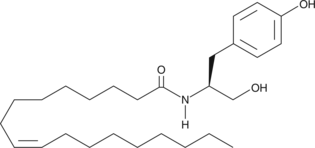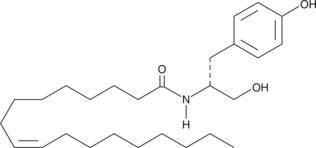Chemicals
Showing 30301–30450 of 41137 results
-
Olsalazine is an orally bioavailable prodrug form of the anti-inflammatory agent 5-aminosalicylic acid (5-ASA; Item No. 70265) that is cleaved by bacterial azo reductases in the gut to generate active 5-ASA.{30379} In vitro, olsalazine increases ion transport in isolated rabbit distal ileum when applied to the luminal side (ED50 = 0.3 mM) and stimulates fluid transport in rat jejunum when used at a concentration of 5 mM.{41622,41623} Olsalazine (150 mg/kg for 8 days) improves stool consistency and decreases occult and gross bleeding as well as myeloperoxidase (MPO) activity and leukotriene B4 (LTB4; Item No. 20110) levels in colon tissue in a mouse model of acute colitis induced by dextran sulfate (Item No. 23250).{41624} Olsalazine also inhibits bovine xanthine oxidase in vitro (IC50 = 3.4 mg/L) and lowers serum uric acid levels in a mouse model of hyperuricemia induced by oxonic acid (Item No. 22586) when administered at a dose of 20 mg/kg.{41625} Formulations containing olsalazine have been used in the treatment of inflammatory bowel disease (IBD) and ulcerative colitis.
Brand:CaymanSKU:23661 - 5 gAvailable on backorder
Olsalazine is an orally bioavailable prodrug form of the anti-inflammatory agent 5-aminosalicylic acid (5-ASA; Item No. 70265) that is cleaved by bacterial azo reductases in the gut to generate active 5-ASA.{30379} In vitro, olsalazine increases ion transport in isolated rabbit distal ileum when applied to the luminal side (ED50 = 0.3 mM) and stimulates fluid transport in rat jejunum when used at a concentration of 5 mM.{41622,41623} Olsalazine (150 mg/kg for 8 days) improves stool consistency and decreases occult and gross bleeding as well as myeloperoxidase (MPO) activity and leukotriene B4 (LTB4; Item No. 20110) levels in colon tissue in a mouse model of acute colitis induced by dextran sulfate (Item No. 23250).{41624} Olsalazine also inhibits bovine xanthine oxidase in vitro (IC50 = 3.4 mg/L) and lowers serum uric acid levels in a mouse model of hyperuricemia induced by oxonic acid (Item No. 22586) when administered at a dose of 20 mg/kg.{41625} Formulations containing olsalazine have been used in the treatment of inflammatory bowel disease (IBD) and ulcerative colitis.
Brand:CaymanSKU:23661 - 500 mgAvailable on backorder
Oltipraz, originally identified as an antischistosomiasis agent, is a potent anticarcinogen in a variety of animal models of cancer at concentrations of ~200 mg/kg.{24177} It is an effective inducer of phase I and II detoxifying enzymes, including glutathione S-transferases, UDP-glucuronosyltransferases, NAD(P)H:quinone oxidoreductase, microsomal epoxide hydrolase, and aflatoxin aldehyde reductase.{24177,24178} Induction of these metabolic enzymes by oltipraz has been linked to the transcription factor nuclear factor E2-related factor 2 and its activation of the antioxidant response element.{24177} In mice, oltipraz at 150 mg/kg can also induce expression of CYP2B, a gene regulated by the constitutive androstane receptor, a transcription factor important in the detoxification of endobiotic and xenobiotic substances.{24179}
Brand:CaymanSKU:-Oltipraz, originally identified as an antischistosomiasis agent, is a potent anticarcinogen in a variety of animal models of cancer at concentrations of ~200 mg/kg.{24177} It is an effective inducer of phase I and II detoxifying enzymes, including glutathione S-transferases, UDP-glucuronosyltransferases, NAD(P)H:quinone oxidoreductase, microsomal epoxide hydrolase, and aflatoxin aldehyde reductase.{24177,24178} Induction of these metabolic enzymes by oltipraz has been linked to the transcription factor nuclear factor E2-related factor 2 and its activation of the antioxidant response element.{24177} In mice, oltipraz at 150 mg/kg can also induce expression of CYP2B, a gene regulated by the constitutive androstane receptor, a transcription factor important in the detoxification of endobiotic and xenobiotic substances.{24179}
Brand:CaymanSKU:-Oltipraz, originally identified as an antischistosomiasis agent, is a potent anticarcinogen in a variety of animal models of cancer at concentrations of ~200 mg/kg.{24177} It is an effective inducer of phase I and II detoxifying enzymes, including glutathione S-transferases, UDP-glucuronosyltransferases, NAD(P)H:quinone oxidoreductase, microsomal epoxide hydrolase, and aflatoxin aldehyde reductase.{24177,24178} Induction of these metabolic enzymes by oltipraz has been linked to the transcription factor nuclear factor E2-related factor 2 and its activation of the antioxidant response element.{24177} In mice, oltipraz at 150 mg/kg can also induce expression of CYP2B, a gene regulated by the constitutive androstane receptor, a transcription factor important in the detoxification of endobiotic and xenobiotic substances.{24179}
Brand:CaymanSKU:-Oltipraz, originally identified as an antischistosomiasis agent, is a potent anticarcinogen in a variety of animal models of cancer at concentrations of ~200 mg/kg.{24177} It is an effective inducer of phase I and II detoxifying enzymes, including glutathione S-transferases, UDP-glucuronosyltransferases, NAD(P)H:quinone oxidoreductase, microsomal epoxide hydrolase, and aflatoxin aldehyde reductase.{24177,24178} Induction of these metabolic enzymes by oltipraz has been linked to the transcription factor nuclear factor E2-related factor 2 and its activation of the antioxidant response element.{24177} In mice, oltipraz at 150 mg/kg can also induce expression of CYP2B, a gene regulated by the constitutive androstane receptor, a transcription factor important in the detoxification of endobiotic and xenobiotic substances.{24179}
Brand:CaymanSKU:-Olvanil is a structural analog of capsaicin, which is the noxious active component of hot peppers of the Capsicum genus. It is the amide of vanillylamine and oleic acid. Olvanil acts as an agonist at the vanilloid receptor, VR1, inducing desensitization analgesia in rat and mouse models of pain.{7203} Olvanil has complex interactions with the cannabinoid system, in that it potentiates the agonist activity of endogenous cannabinoids by inhibiting the reuptake of arachidonyl ethanolamide (AEA). Olvanil is a more potent reuptake inhibitor than AM404, which is commonly used for this purpose (50% inhibition of reuptake at 10 µM versus 12% for AM404 at the same dose).{7209} Olvanil is also a CB1 agonist, but does not bind to CB2 receptors or inhibit fatty acid amide hydrolase. The overall activity of olvanil in most models is that of an analgesic, but it is unclear how these effects are mediated by VR1, the CB1 receptor, or other components of the endogenous pain sensation system.
Brand:CaymanSKU:90262 - 10 mgAvailable on backorder
Olvanil is a structural analog of capsaicin, which is the noxious active component of hot peppers of the Capsicum genus. It is the amide of vanillylamine and oleic acid. Olvanil acts as an agonist at the vanilloid receptor, VR1, inducing desensitization analgesia in rat and mouse models of pain.{7203} Olvanil has complex interactions with the cannabinoid system, in that it potentiates the agonist activity of endogenous cannabinoids by inhibiting the reuptake of arachidonyl ethanolamide (AEA). Olvanil is a more potent reuptake inhibitor than AM404, which is commonly used for this purpose (50% inhibition of reuptake at 10 µM versus 12% for AM404 at the same dose).{7209} Olvanil is also a CB1 agonist, but does not bind to CB2 receptors or inhibit fatty acid amide hydrolase. The overall activity of olvanil in most models is that of an analgesic, but it is unclear how these effects are mediated by VR1, the CB1 receptor, or other components of the endogenous pain sensation system.
Brand:CaymanSKU:90262 - 25 mgAvailable on backorder
Olvanil is a structural analog of capsaicin, which is the noxious active component of hot peppers of the Capsicum genus. It is the amide of vanillylamine and oleic acid. Olvanil acts as an agonist at the vanilloid receptor, VR1, inducing desensitization analgesia in rat and mouse models of pain.{7203} Olvanil has complex interactions with the cannabinoid system, in that it potentiates the agonist activity of endogenous cannabinoids by inhibiting the reuptake of arachidonyl ethanolamide (AEA). Olvanil is a more potent reuptake inhibitor than AM404, which is commonly used for this purpose (50% inhibition of reuptake at 10 µM versus 12% for AM404 at the same dose).{7209} Olvanil is also a CB1 agonist, but does not bind to CB2 receptors or inhibit fatty acid amide hydrolase. The overall activity of olvanil in most models is that of an analgesic, but it is unclear how these effects are mediated by VR1, the CB1 receptor, or other components of the endogenous pain sensation system.
Brand:CaymanSKU:90262 - 5 mgAvailable on backorder
Olvanil is a structural analog of capsaicin, which is the noxious active component of hot peppers of the Capsicum genus. It is the amide of vanillylamine and oleic acid. Olvanil acts as an agonist at the vanilloid receptor, VR1, inducing desensitization analgesia in rat and mouse models of pain.{7203} Olvanil has complex interactions with the cannabinoid system, in that it potentiates the agonist activity of endogenous cannabinoids by inhibiting the reuptake of arachidonyl ethanolamide (AEA). Olvanil is a more potent reuptake inhibitor than AM404, which is commonly used for this purpose (50% inhibition of reuptake at 10 µM versus 12% for AM404 at the same dose).{7209} Olvanil is also a CB1 agonist, but does not bind to CB2 receptors or inhibit fatty acid amide hydrolase. The overall activity of olvanil in most models is that of an analgesic, but it is unclear how these effects are mediated by VR1, the CB1 receptor, or other components of the endogenous pain sensation system.
Brand:CaymanSKU:90262 - 50 mgAvailable on backorder
OM173-αA is a quinone bacterial metabolite originally isolated from Streptomyces that has antimicrobial activity.{45188,45189} It inhibits the growth of the bacteria M. gallisepticum, M. pneumoniae, and S. aureus in vitro with MIC values ranging from 0.39 to 3.13 μg/ml. OM173-αA also inhibits the growth of the plant pathogenic fungus P. oryzae (MIC = 3.12 μg/ml) and several species of Trichophyton (MICs = 12.5-25 μg/ml).{45188}
Brand:CaymanSKU:27570 - 1 mgAvailable on backorder
OM173-αA is a quinone bacterial metabolite originally isolated from Streptomyces that has antimicrobial activity.{45188,45189} It inhibits the growth of the bacteria M. gallisepticum, M. pneumoniae, and S. aureus in vitro with MIC values ranging from 0.39 to 3.13 μg/ml. OM173-αA also inhibits the growth of the plant pathogenic fungus P. oryzae (MIC = 3.12 μg/ml) and several species of Trichophyton (MICs = 12.5-25 μg/ml).{45188}
Brand:CaymanSKU:27570 - 5 mgAvailable on backorder
OM173-αA is a quinone bacterial metabolite originally isolated from Streptomyces that has antimicrobial activity.{45188,45189} It inhibits the growth of the bacteria M. gallisepticum, M. pneumoniae, and S. aureus in vitro with MIC values ranging from 0.39 to 3.13 μg/ml. OM173-αA also inhibits the growth of the plant pathogenic fungus P. oryzae (MIC = 3.12 μg/ml) and several species of Trichophyton (MICs = 12.5-25 μg/ml).{45188}
Brand:CaymanSKU:27570 - 500 µgAvailable on backorder
Ombitasvir is an orally bioavailable and potent inhibitor of the hepatitis C virus (HCV) non-structural protein 5A (NS5A).{32953,38818} It reduces HCV replication in stable replicon cell lines with EC50 values ranging from 0.82 to 19.3 pM against genotypes 1a, 1b, 2a, 2b, 3a, 4a, and 5a and an EC50 value of 366 pM for genotype 6a.{32953,38818} Against subgenomic replicons from clinical isolates of genotypes 1a-6a expressed in Huh-7 derived cells, ombitasvir inhibits HCV replication with EC50 values ranging from 0.1 pM for genotype 4a to 68 pM for genotype 6a.{38818} Formulations containing ombitasvir have been used in the treatment of HCV genotypes 1 and 4.
Brand:CaymanSKU:24116 - 1 mgAvailable on backorder
Ombitasvir is an orally bioavailable and potent inhibitor of the hepatitis C virus (HCV) non-structural protein 5A (NS5A).{32953,38818} It reduces HCV replication in stable replicon cell lines with EC50 values ranging from 0.82 to 19.3 pM against genotypes 1a, 1b, 2a, 2b, 3a, 4a, and 5a and an EC50 value of 366 pM for genotype 6a.{32953,38818} Against subgenomic replicons from clinical isolates of genotypes 1a-6a expressed in Huh-7 derived cells, ombitasvir inhibits HCV replication with EC50 values ranging from 0.1 pM for genotype 4a to 68 pM for genotype 6a.{38818} Formulations containing ombitasvir have been used in the treatment of HCV genotypes 1 and 4.
Brand:CaymanSKU:24116 - 5 mgAvailable on backorder
Ombitasvir is an orally bioavailable and potent inhibitor of the hepatitis C virus (HCV) non-structural protein 5A (NS5A).{32953,38818} It reduces HCV replication in stable replicon cell lines with EC50 values ranging from 0.82 to 19.3 pM against genotypes 1a, 1b, 2a, 2b, 3a, 4a, and 5a and an EC50 value of 366 pM for genotype 6a.{32953,38818} Against subgenomic replicons from clinical isolates of genotypes 1a-6a expressed in Huh-7 derived cells, ombitasvir inhibits HCV replication with EC50 values ranging from 0.1 pM for genotype 4a to 68 pM for genotype 6a.{38818} Formulations containing ombitasvir have been used in the treatment of HCV genotypes 1 and 4.
Brand:CaymanSKU:24116 - 500 µgAvailable on backorder
Numerous analogs of arachidonoyl ethanolamide{10254} (AEA, anandamide; Item No. 90050) potentiate its biological activity. This potentiation is ascribed either to inhibition of AEA reuptake into neurons or inhibition of fatty acid amide hydrolase (FAAH) within the neurons.{10647} OMDM-1 is an endocannabinoid analog specifically designed to be a potent and selective inhibitor of the cellular uptake of AEA.{11240} Structurally, OMDM-1 is the amide of (S)-tyrosinol with oleic acid (Item No. 90260). In RBL-2H3 cells, OMDM-1 inhibits the cellular uptake of tritiated AEA with an IC50 of 2.4 µM, with negligible effects on the CB1 receptor and VR1.{11240}
Brand:CaymanSKU:10171 - 1 mgAvailable on backorder
Numerous analogs of arachidonoyl ethanolamide{10254} (AEA, anandamide; Item No. 90050) potentiate its biological activity. This potentiation is ascribed either to inhibition of AEA reuptake into neurons or inhibition of fatty acid amide hydrolase (FAAH) within the neurons.{10647} OMDM-1 is an endocannabinoid analog specifically designed to be a potent and selective inhibitor of the cellular uptake of AEA.{11240} Structurally, OMDM-1 is the amide of (S)-tyrosinol with oleic acid (Item No. 90260). In RBL-2H3 cells, OMDM-1 inhibits the cellular uptake of tritiated AEA with an IC50 of 2.4 µM, with negligible effects on the CB1 receptor and VR1.{11240}
Brand:CaymanSKU:10171 - 10 mgAvailable on backorder
Numerous analogs of arachidonoyl ethanolamide{10254} (AEA, anandamide; Item No. 90050) potentiate its biological activity. This potentiation is ascribed either to inhibition of AEA reuptake into neurons or inhibition of fatty acid amide hydrolase (FAAH) within the neurons.{10647} OMDM-1 is an endocannabinoid analog specifically designed to be a potent and selective inhibitor of the cellular uptake of AEA.{11240} Structurally, OMDM-1 is the amide of (S)-tyrosinol with oleic acid (Item No. 90260). In RBL-2H3 cells, OMDM-1 inhibits the cellular uptake of tritiated AEA with an IC50 of 2.4 µM, with negligible effects on the CB1 receptor and VR1.{11240}
Brand:CaymanSKU:10171 - 5 mgAvailable on backorder
Numerous analogs of arachidonoyl ethanolamide{10254} (AEA, anandamide; Item No. 90050) potentiate its biological activity. This potentiation is ascribed either to inhibition of AEA reuptake into neurons or inhibition of fatty acid amide hydrolase (FAAH) within the neurons.{10647} OMDM-1 is an endocannabinoid analog specifically designed to be a potent and selective inhibitor of the cellular uptake of AEA.{11240} Structurally, OMDM-1 is the amide of (S)-tyrosinol with oleic acid (Item No. 90260). In RBL-2H3 cells, OMDM-1 inhibits the cellular uptake of tritiated AEA with an IC50 of 2.4 µM, with negligible effects on the CB1 receptor and VR1.{11240}
Brand:CaymanSKU:10171 - 50 mgAvailable on backorder
Numerous analogs of arachidonoyl ethanolamide{10254} (AEA, anandamide; Item No. 90050) potentiate its biological activity. This potentiation is ascribed either to inhibition of AEA reuptake into neurons, or inhibition of fatty acid amide hydrolase (FAAH) within the neurons.{10647} OMDM-2 is an endocannabinoid analog specifically designed to be a potent and selective inhibitor of the cellular uptake of AEA.{11240} Structurally, OMDM-2 is the amide of (R)-tyrosinol with oleic acid. In RBL-2H3 cells, OMDM-2 inhibits the cellular uptake of tritiated AEA with an IC50 of 3 µM, with negligible effects on the CB1 receptor and VR1.{11240}
Brand:CaymanSKU:10179 - 1 mgAvailable on backorder
Numerous analogs of arachidonoyl ethanolamide{10254} (AEA, anandamide; Item No. 90050) potentiate its biological activity. This potentiation is ascribed either to inhibition of AEA reuptake into neurons, or inhibition of fatty acid amide hydrolase (FAAH) within the neurons.{10647} OMDM-2 is an endocannabinoid analog specifically designed to be a potent and selective inhibitor of the cellular uptake of AEA.{11240} Structurally, OMDM-2 is the amide of (R)-tyrosinol with oleic acid. In RBL-2H3 cells, OMDM-2 inhibits the cellular uptake of tritiated AEA with an IC50 of 3 µM, with negligible effects on the CB1 receptor and VR1.{11240}
Brand:CaymanSKU:10179 - 10 mgAvailable on backorder
Numerous analogs of arachidonoyl ethanolamide{10254} (AEA, anandamide; Item No. 90050) potentiate its biological activity. This potentiation is ascribed either to inhibition of AEA reuptake into neurons, or inhibition of fatty acid amide hydrolase (FAAH) within the neurons.{10647} OMDM-2 is an endocannabinoid analog specifically designed to be a potent and selective inhibitor of the cellular uptake of AEA.{11240} Structurally, OMDM-2 is the amide of (R)-tyrosinol with oleic acid. In RBL-2H3 cells, OMDM-2 inhibits the cellular uptake of tritiated AEA with an IC50 of 3 µM, with negligible effects on the CB1 receptor and VR1.{11240}
Brand:CaymanSKU:10179 - 5 mgAvailable on backorder
Numerous analogs of arachidonoyl ethanolamide{10254} (AEA, anandamide; Item No. 90050) potentiate its biological activity. This potentiation is ascribed either to inhibition of AEA reuptake into neurons, or inhibition of fatty acid amide hydrolase (FAAH) within the neurons.{10647} OMDM-2 is an endocannabinoid analog specifically designed to be a potent and selective inhibitor of the cellular uptake of AEA.{11240} Structurally, OMDM-2 is the amide of (R)-tyrosinol with oleic acid. In RBL-2H3 cells, OMDM-2 inhibits the cellular uptake of tritiated AEA with an IC50 of 3 µM, with negligible effects on the CB1 receptor and VR1.{11240}
Brand:CaymanSKU:10179 - 50 mgAvailable on backorder
Omeprazole is a selective and irreversible inhibitor of the gastric H+/K+ ATPase pump (IC50 = 1.1 μM).{14045} It is a racemic mixture of two enantiomers, (S)-omeprazole (esomeprazole; Item No. 17326) and (R)-omeprazole (Item No. 18874), which are prodrugs of the active sulfonamide formed by acid-stimulated conversion.{18256,18249} Both enantiomers are extensively metabolized by the cytochrome P450 (CYP) isomers CYP2C19 and CYP3A4.{18249}
Brand:CaymanSKU:-Omeprazole is a selective and irreversible inhibitor of the gastric H+/K+ ATPase pump (IC50 = 1.1 μM).{14045} It is a racemic mixture of two enantiomers, (S)-omeprazole (esomeprazole; Item No. 17326) and (R)-omeprazole (Item No. 18874), which are prodrugs of the active sulfonamide formed by acid-stimulated conversion.{18256,18249} Both enantiomers are extensively metabolized by the cytochrome P450 (CYP) isomers CYP2C19 and CYP3A4.{18249}
Brand:CaymanSKU:-Omeprazole is a selective and irreversible inhibitor of the gastric H+/K+ ATPase pump (IC50 = 1.1 μM).{14045} It is a racemic mixture of two enantiomers, (S)-omeprazole (esomeprazole; Item No. 17326) and (R)-omeprazole (Item No. 18874), which are prodrugs of the active sulfonamide formed by acid-stimulated conversion.{18256,18249} Both enantiomers are extensively metabolized by the cytochrome P450 (CYP) isomers CYP2C19 and CYP3A4.{18249}
Brand:CaymanSKU:-Omeprazole is a selective and irreversible inhibitor of the gastric H+/K+ ATPase pump (IC50 = 1.1 μM).{14045} It is a racemic mixture of two enantiomers, (S)-omeprazole (esomeprazole; Item No. 17326) and (R)-omeprazole (Item No. 18874), which are prodrugs of the active sulfonamide formed by acid-stimulated conversion.{18256,18249} Both enantiomers are extensively metabolized by the cytochrome P450 (CYP) isomers CYP2C19 and CYP3A4.{18249}
Brand:CaymanSKU:-Omeprazole sulfide is an intermediate used in the production of the gastric proton pump inhibitors, omeprazole (Item No. 14880) and esomeprazole (Item No. 17326).{31117} As a degradation product, it is reported to be a direct-acting inhibitor of cytochrome P450 2C19 in pooled human liver microsomes (IC50 = 9.7 µM).{30672}
Brand:CaymanSKU:-Available on backorder
Omeprazole sulfide is an intermediate used in the production of the gastric proton pump inhibitors, omeprazole (Item No. 14880) and esomeprazole (Item No. 17326).{31117} As a degradation product, it is reported to be a direct-acting inhibitor of cytochrome P450 2C19 in pooled human liver microsomes (IC50 = 9.7 µM).{30672}
Brand:CaymanSKU:-Available on backorder
Omeprazole sulfide is an intermediate used in the production of the gastric proton pump inhibitors, omeprazole (Item No. 14880) and esomeprazole (Item No. 17326).{31117} As a degradation product, it is reported to be a direct-acting inhibitor of cytochrome P450 2C19 in pooled human liver microsomes (IC50 = 9.7 µM).{30672}
Brand:CaymanSKU:-Available on backorder
Omeprazole sulfide is an intermediate used in the production of the gastric proton pump inhibitors, omeprazole (Item No. 14880) and esomeprazole (Item No. 17326).{31117} As a degradation product, it is reported to be a direct-acting inhibitor of cytochrome P450 2C19 in pooled human liver microsomes (IC50 = 9.7 µM).{30672}
Brand:CaymanSKU:-Available on backorder
Omeprazole sulfone is the major metabolite of the gastric proton pump inhibitor, omeprazole (Item No. 14880). It is produced by cytochrome P450 (CYP)3A4 sulfoxidation of esomeprazole (Item No. 17326) and is found in plasma.{30673} Omeprazole sulfone has been shown to act as a reversible direct-acting and metabolism-dependent inhibitor of CYP2C19 in pooled human liver microsomes (IC50 = 18 µM).{30672}
Brand:CaymanSKU:-Available on backorder
Omeprazole sulfone is the major metabolite of the gastric proton pump inhibitor, omeprazole (Item No. 14880). It is produced by cytochrome P450 (CYP)3A4 sulfoxidation of esomeprazole (Item No. 17326) and is found in plasma.{30673} Omeprazole sulfone has been shown to act as a reversible direct-acting and metabolism-dependent inhibitor of CYP2C19 in pooled human liver microsomes (IC50 = 18 µM).{30672}
Brand:CaymanSKU:-Available on backorder
Omeprazole sulfone is the major metabolite of the gastric proton pump inhibitor, omeprazole (Item No. 14880). It is produced by cytochrome P450 (CYP)3A4 sulfoxidation of esomeprazole (Item No. 17326) and is found in plasma.{30673} Omeprazole sulfone has been shown to act as a reversible direct-acting and metabolism-dependent inhibitor of CYP2C19 in pooled human liver microsomes (IC50 = 18 µM).{30672}
Brand:CaymanSKU:-Available on backorder
Omeprazole sulfone is the major metabolite of the gastric proton pump inhibitor, omeprazole (Item No. 14880). It is produced by cytochrome P450 (CYP)3A4 sulfoxidation of esomeprazole (Item No. 17326) and is found in plasma.{30673} Omeprazole sulfone has been shown to act as a reversible direct-acting and metabolism-dependent inhibitor of CYP2C19 in pooled human liver microsomes (IC50 = 18 µM).{30672}
Brand:CaymanSKU:-Available on backorder
Omeprazole-d3 is intended for use as an internal standard for the quantification of omeprazole (Item No. 14880) by GC- or LC-MS. Omeprazole is a selective and irreversible inhibitor of the gastric H+/K+ ATPase pump (IC50 = 1.1 μM).{14045} It is a racemic mixture of two enantiomers, S-omeprazole (esomeprazole magnesium; Item No. 17326) and R-omeprazole (sodium salt) (Item No. 18874), which are prodrugs of the active sulfonamide which is formed by acid-stimulated conversion.{18256,18249} Both enantiomers are extensively metabolized by the cytochrome P450 (CYP) isomers CYP2C19 and CYP3A4.{18249}
Brand:CaymanSKU:22087 -Out of stock
Omeprazole-d3 is intended for use as an internal standard for the quantification of omeprazole (Item No. 14880) by GC- or LC-MS. Omeprazole is a selective and irreversible inhibitor of the gastric H+/K+ ATPase pump (IC50 = 1.1 μM).{14045} It is a racemic mixture of two enantiomers, S-omeprazole (esomeprazole magnesium; Item No. 17326) and R-omeprazole (sodium salt) (Item No. 18874), which are prodrugs of the active sulfonamide which is formed by acid-stimulated conversion.{18256,18249} Both enantiomers are extensively metabolized by the cytochrome P450 (CYP) isomers CYP2C19 and CYP3A4.{18249}
Brand:CaymanSKU:22087 -Out of stock
Omeprazole-d3 is intended for use as an internal standard for the quantification of omeprazole (Item No. 14880) by GC- or LC-MS. Omeprazole is a selective and irreversible inhibitor of the gastric H+/K+ ATPase pump (IC50 = 1.1 μM).{14045} It is a racemic mixture of two enantiomers, S-omeprazole (esomeprazole magnesium; Item No. 17326) and R-omeprazole (sodium salt) (Item No. 18874), which are prodrugs of the active sulfonamide which is formed by acid-stimulated conversion.{18256,18249} Both enantiomers are extensively metabolized by the cytochrome P450 (CYP) isomers CYP2C19 and CYP3A4.{18249}
Brand:CaymanSKU:22087 -Out of stock
ON-01910 is a potent, non-ATP-competitive inhibitor of polo-like kinase 1 (Plk1; IC50 = 9 nM), a serine/threonine protein kinase involved in the regulation of cell cycling.{28096} It induces apoptosis in a wide array of tumor cell lines (GI50 = 50-200 nM) and blocks the growth of multidrug resistant cancer cell lines.{28096,28095,28097,28098} ON-01910 is active in vivo when administered intraperitoneally and synergizes with chemotherapeutic agents, preventing tumor growth or abolishing tumors in human xenograft nude mouse models.{28096}
Brand:CaymanSKU:-ON-01910 is a potent, non-ATP-competitive inhibitor of polo-like kinase 1 (Plk1; IC50 = 9 nM), a serine/threonine protein kinase involved in the regulation of cell cycling.{28096} It induces apoptosis in a wide array of tumor cell lines (GI50 = 50-200 nM) and blocks the growth of multidrug resistant cancer cell lines.{28096,28095,28097,28098} ON-01910 is active in vivo when administered intraperitoneally and synergizes with chemotherapeutic agents, preventing tumor growth or abolishing tumors in human xenograft nude mouse models.{28096}
Brand:CaymanSKU:-ON-01910 is a potent, non-ATP-competitive inhibitor of polo-like kinase 1 (Plk1; IC50 = 9 nM), a serine/threonine protein kinase involved in the regulation of cell cycling.{28096} It induces apoptosis in a wide array of tumor cell lines (GI50 = 50-200 nM) and blocks the growth of multidrug resistant cancer cell lines.{28096,28095,28097,28098} ON-01910 is active in vivo when administered intraperitoneally and synergizes with chemotherapeutic agents, preventing tumor growth or abolishing tumors in human xenograft nude mouse models.{28096}
Brand:CaymanSKU:-ON-01910 is a potent, non-ATP-competitive inhibitor of polo-like kinase 1 (Plk1; IC50 = 9 nM), a serine/threonine protein kinase involved in the regulation of cell cycling.{28096} It induces apoptosis in a wide array of tumor cell lines (GI50 = 50-200 nM) and blocks the growth of multidrug resistant cancer cell lines.{28096,28095,28097,28098} ON-01910 is active in vivo when administered intraperitoneally and synergizes with chemotherapeutic agents, preventing tumor growth or abolishing tumors in human xenograft nude mouse models.{28096}
Brand:CaymanSKU:-ON-123300 is a multi-kinase inhibitor.{43515,43516} It inhibits ARK5, Cdk4, and Cdk6 (IC50s = 3.87, 9.82, and 4.95 nM, respectively) as well as FYN, PDGFRβ, Abl, and PI3Kδ (IC50s = 11.09, 26, 53.32, and 144 nM, respectively) among others.{43516} It inhibits proliferation in a panel of 38 cancer cell lines (GI50s = 0.05-5 µM).{43516} ON-123300 also inhibits proliferation of U87 glioma cells (IC50 = 3.4 µM), decreases phosphorylation of Akt and activates ERK, as well as halts the cell cycle in the G2/M phase and induces apoptosis.{43515} When used in combination with the EGFR inhibitor gefitinib (Item No. 13166), it synergistically induces cytotoxicity of U87, U87 VIII, and U87 PTEN cells. ON-123300 reduces tumor growth in an MDA-MB-231 mouse xenograft model when administered at a dose of 50 mg/kg every other day.{43516}
Brand:CaymanSKU:19902 -Available on backorder
ON-123300 is a multi-kinase inhibitor.{43515,43516} It inhibits ARK5, Cdk4, and Cdk6 (IC50s = 3.87, 9.82, and 4.95 nM, respectively) as well as FYN, PDGFRβ, Abl, and PI3Kδ (IC50s = 11.09, 26, 53.32, and 144 nM, respectively) among others.{43516} It inhibits proliferation in a panel of 38 cancer cell lines (GI50s = 0.05-5 µM).{43516} ON-123300 also inhibits proliferation of U87 glioma cells (IC50 = 3.4 µM), decreases phosphorylation of Akt and activates ERK, as well as halts the cell cycle in the G2/M phase and induces apoptosis.{43515} When used in combination with the EGFR inhibitor gefitinib (Item No. 13166), it synergistically induces cytotoxicity of U87, U87 VIII, and U87 PTEN cells. ON-123300 reduces tumor growth in an MDA-MB-231 mouse xenograft model when administered at a dose of 50 mg/kg every other day.{43516}
Brand:CaymanSKU:19902 -Available on backorder
ON-123300 is a multi-kinase inhibitor.{43515,43516} It inhibits ARK5, Cdk4, and Cdk6 (IC50s = 3.87, 9.82, and 4.95 nM, respectively) as well as FYN, PDGFRβ, Abl, and PI3Kδ (IC50s = 11.09, 26, 53.32, and 144 nM, respectively) among others.{43516} It inhibits proliferation in a panel of 38 cancer cell lines (GI50s = 0.05-5 µM).{43516} ON-123300 also inhibits proliferation of U87 glioma cells (IC50 = 3.4 µM), decreases phosphorylation of Akt and activates ERK, as well as halts the cell cycle in the G2/M phase and induces apoptosis.{43515} When used in combination with the EGFR inhibitor gefitinib (Item No. 13166), it synergistically induces cytotoxicity of U87, U87 VIII, and U87 PTEN cells. ON-123300 reduces tumor growth in an MDA-MB-231 mouse xenograft model when administered at a dose of 50 mg/kg every other day.{43516}
Brand:CaymanSKU:19902 -Available on backorder
ON-123300 is a multi-kinase inhibitor.{43515,43516} It inhibits ARK5, Cdk4, and Cdk6 (IC50s = 3.87, 9.82, and 4.95 nM, respectively) as well as FYN, PDGFRβ, Abl, and PI3Kδ (IC50s = 11.09, 26, 53.32, and 144 nM, respectively) among others.{43516} It inhibits proliferation in a panel of 38 cancer cell lines (GI50s = 0.05-5 µM).{43516} ON-123300 also inhibits proliferation of U87 glioma cells (IC50 = 3.4 µM), decreases phosphorylation of Akt and activates ERK, as well as halts the cell cycle in the G2/M phase and induces apoptosis.{43515} When used in combination with the EGFR inhibitor gefitinib (Item No. 13166), it synergistically induces cytotoxicity of U87, U87 VIII, and U87 PTEN cells. ON-123300 reduces tumor growth in an MDA-MB-231 mouse xenograft model when administered at a dose of 50 mg/kg every other day.{43516}
Brand:CaymanSKU:19902 -Available on backorder
Onalespib is a selective inhibitor of Hsp90 (IC50 = 18 nM).{18725} It induces the degradation of specific Hsp90 client proteins, including mutant EGFR, for up to seven days in tumor cell lines in vitro and up to three days in vivo.{18725,33082} Onalespib is retained in tumor xenografts and is efficacious in a range of xenograft models.{33082}
Brand:CaymanSKU:10655 - 1 mgAvailable on backorder
Onalespib is a selective inhibitor of Hsp90 (IC50 = 18 nM).{18725} It induces the degradation of specific Hsp90 client proteins, including mutant EGFR, for up to seven days in tumor cell lines in vitro and up to three days in vivo.{18725,33082} Onalespib is retained in tumor xenografts and is efficacious in a range of xenograft models.{33082}
Brand:CaymanSKU:10655 - 10 mgAvailable on backorder
Onalespib is a selective inhibitor of Hsp90 (IC50 = 18 nM).{18725} It induces the degradation of specific Hsp90 client proteins, including mutant EGFR, for up to seven days in tumor cell lines in vitro and up to three days in vivo.{18725,33082} Onalespib is retained in tumor xenografts and is efficacious in a range of xenograft models.{33082}
Brand:CaymanSKU:10655 - 25 mgAvailable on backorder
Onalespib is a selective inhibitor of Hsp90 (IC50 = 18 nM).{18725} It induces the degradation of specific Hsp90 client proteins, including mutant EGFR, for up to seven days in tumor cell lines in vitro and up to three days in vivo.{18725,33082} Onalespib is retained in tumor xenografts and is efficacious in a range of xenograft models.{33082}
Brand:CaymanSKU:10655 - 5 mgAvailable on backorder
ONC212 is an agonist of the orphan G protein-coupled receptor GPR132 (EC50 = ~400 nM in a PathHunter® β-arrestin assay).{52749} It inhibits cell growth in a panel of 62 human leukemia cell lines, including acute myeloid leukemia (AML), acute lymphoblastic leukemia (ALL), chronic myelogenous leukemia (CML), and hairy cell leukemias, with GI50 values ranging from less than 78 to 456 nM. ONC212 also reduces cell growth in a panel of 58 lymphoma cell lines (GI50s = In vivo, ONC212 (50 mg/kg) reduces tumor volume in HT-29 and HCT116 mouse xenograft models.{52750}
Brand:CaymanSKU:30931 - 1 mgAvailable on backorder
ONC212 is an agonist of the orphan G protein-coupled receptor GPR132 (EC50 = ~400 nM in a PathHunter® β-arrestin assay).{52749} It inhibits cell growth in a panel of 62 human leukemia cell lines, including acute myeloid leukemia (AML), acute lymphoblastic leukemia (ALL), chronic myelogenous leukemia (CML), and hairy cell leukemias, with GI50 values ranging from less than 78 to 456 nM. ONC212 also reduces cell growth in a panel of 58 lymphoma cell lines (GI50s = In vivo, ONC212 (50 mg/kg) reduces tumor volume in HT-29 and HCT116 mouse xenograft models.{52750}
Brand:CaymanSKU:30931 - 10 mgAvailable on backorder
ONC212 is an agonist of the orphan G protein-coupled receptor GPR132 (EC50 = ~400 nM in a PathHunter® β-arrestin assay).{52749} It inhibits cell growth in a panel of 62 human leukemia cell lines, including acute myeloid leukemia (AML), acute lymphoblastic leukemia (ALL), chronic myelogenous leukemia (CML), and hairy cell leukemias, with GI50 values ranging from less than 78 to 456 nM. ONC212 also reduces cell growth in a panel of 58 lymphoma cell lines (GI50s = In vivo, ONC212 (50 mg/kg) reduces tumor volume in HT-29 and HCT116 mouse xenograft models.{52750}
Brand:CaymanSKU:30931 - 25 mgAvailable on backorder
ONC212 is an agonist of the orphan G protein-coupled receptor GPR132 (EC50 = ~400 nM in a PathHunter® β-arrestin assay).{52749} It inhibits cell growth in a panel of 62 human leukemia cell lines, including acute myeloid leukemia (AML), acute lymphoblastic leukemia (ALL), chronic myelogenous leukemia (CML), and hairy cell leukemias, with GI50 values ranging from less than 78 to 456 nM. ONC212 also reduces cell growth in a panel of 58 lymphoma cell lines (GI50s = In vivo, ONC212 (50 mg/kg) reduces tumor volume in HT-29 and HCT116 mouse xenograft models.{52750}
Brand:CaymanSKU:30931 - 5 mgAvailable on backorder
Oncrasin-1 is an anticancer agent that has activity against lung cancer cells expressing constitutively active K-Ras (IC50s = 0.25, 1, 1.58, and 0.11 for H460, H2122, A549, and H2887 cells, respectively).{42558} It induces nuclear aggregation of atypical protein kinase C (aPKC) PKCι and apoptosis in T29Kt1 and H460 cells. Oncrasin-1 (100 mg/kg per day) reduces tumor volume and increases survival time in an H460 mouse xenograft model.
Brand:CaymanSKU:25808 - 10 mgAvailable on backorder
Oncrasin-1 is an anticancer agent that has activity against lung cancer cells expressing constitutively active K-Ras (IC50s = 0.25, 1, 1.58, and 0.11 for H460, H2122, A549, and H2887 cells, respectively).{42558} It induces nuclear aggregation of atypical protein kinase C (aPKC) PKCι and apoptosis in T29Kt1 and H460 cells. Oncrasin-1 (100 mg/kg per day) reduces tumor volume and increases survival time in an H460 mouse xenograft model.
Brand:CaymanSKU:25808 - 100 mgAvailable on backorder
Oncrasin-1 is an anticancer agent that has activity against lung cancer cells expressing constitutively active K-Ras (IC50s = 0.25, 1, 1.58, and 0.11 for H460, H2122, A549, and H2887 cells, respectively).{42558} It induces nuclear aggregation of atypical protein kinase C (aPKC) PKCι and apoptosis in T29Kt1 and H460 cells. Oncrasin-1 (100 mg/kg per day) reduces tumor volume and increases survival time in an H460 mouse xenograft model.
Brand:CaymanSKU:25808 - 25 mgAvailable on backorder
Oncrasin-1 is an anticancer agent that has activity against lung cancer cells expressing constitutively active K-Ras (IC50s = 0.25, 1, 1.58, and 0.11 for H460, H2122, A549, and H2887 cells, respectively).{42558} It induces nuclear aggregation of atypical protein kinase C (aPKC) PKCι and apoptosis in T29Kt1 and H460 cells. Oncrasin-1 (100 mg/kg per day) reduces tumor volume and increases survival time in an H460 mouse xenograft model.
Brand:CaymanSKU:25808 - 50 mgAvailable on backorder
Onjisaponin B is a triterpenoid saponin that has been found in P. tenuifolia and has neuroprotective activity.{49643,49644,49645} It inhibits glutamate- or serum-starvation-induced neurotoxicity in PC12 cells when used at a concentration of 10 μM.{49643} Onjisaponin B decreases amyloid-β production in HEK293/APPswe cells (IC50 = 10 μM).{49644} It reduces spatial learning and memory deficits in the Morris water maze in an APP/PS1 transgenic mouse model of Alzheimer’s disease when administered at a dose of 10 mg/kg per day. Onjisaponin B (10 and 20 mg/kg) prevents D-galactose-induced decreases in hippocampal glutathione (GSH) levels and increases in hippocampal malondialdehyde (MDA), IL-1β, IL-6, and TNF-α levels in a rat model of D-galactose-induced aging.{49645}
Brand:CaymanSKU:30521 - 1 mgAvailable on backorder
Onjisaponin B is a triterpenoid saponin that has been found in P. tenuifolia and has neuroprotective activity.{49643,49644,49645} It inhibits glutamate- or serum-starvation-induced neurotoxicity in PC12 cells when used at a concentration of 10 μM.{49643} Onjisaponin B decreases amyloid-β production in HEK293/APPswe cells (IC50 = 10 μM).{49644} It reduces spatial learning and memory deficits in the Morris water maze in an APP/PS1 transgenic mouse model of Alzheimer’s disease when administered at a dose of 10 mg/kg per day. Onjisaponin B (10 and 20 mg/kg) prevents D-galactose-induced decreases in hippocampal glutathione (GSH) levels and increases in hippocampal malondialdehyde (MDA), IL-1β, IL-6, and TNF-α levels in a rat model of D-galactose-induced aging.{49645}
Brand:CaymanSKU:30521 - 10 mgAvailable on backorder
Onjisaponin B is a triterpenoid saponin that has been found in P. tenuifolia and has neuroprotective activity.{49643,49644,49645} It inhibits glutamate- or serum-starvation-induced neurotoxicity in PC12 cells when used at a concentration of 10 μM.{49643} Onjisaponin B decreases amyloid-β production in HEK293/APPswe cells (IC50 = 10 μM).{49644} It reduces spatial learning and memory deficits in the Morris water maze in an APP/PS1 transgenic mouse model of Alzheimer’s disease when administered at a dose of 10 mg/kg per day. Onjisaponin B (10 and 20 mg/kg) prevents D-galactose-induced decreases in hippocampal glutathione (GSH) levels and increases in hippocampal malondialdehyde (MDA), IL-1β, IL-6, and TNF-α levels in a rat model of D-galactose-induced aging.{49645}
Brand:CaymanSKU:30521 - 5 mgAvailable on backorder
ONO-4059 analog is the [(3S)-1-(1-oxo-2-propen-1-yl)-3-piperidinyl] analog of the recently published structure of ONO-4059.{31345} ONO-4059 is an orally bioavailable inhibitor of Bruton’s tyrosine kinase (BTK; IC50 = 2.2 nM), a non-receptor tyrosine kinase involved in signal transduction pathways regulating the proliferation, activation, and differentiation of B cells.{30641} ONO-4059 reversibly blocks B cell receptor signaling and B cell proliferation and activation.{30641} ONO-4059 suppresses the generation of inflammatory chemokines and cytokines in a mouse model of collagen-induced arthritis, resulting in regression of cartilage erosion, bone damage, and pannus formation.{30641} ONO-4059 is in clinical trials concerning certain leukemias and lymphomas, including chronic lymphocytic leukemia.{30642,30643,31345} The actions of ONO-4059 analog have not been studied.
Brand:CaymanSKU:-Available on backorder
ONO-4059 analog is the [(3S)-1-(1-oxo-2-propen-1-yl)-3-piperidinyl] analog of the recently published structure of ONO-4059.{31345} ONO-4059 is an orally bioavailable inhibitor of Bruton’s tyrosine kinase (BTK; IC50 = 2.2 nM), a non-receptor tyrosine kinase involved in signal transduction pathways regulating the proliferation, activation, and differentiation of B cells.{30641} ONO-4059 reversibly blocks B cell receptor signaling and B cell proliferation and activation.{30641} ONO-4059 suppresses the generation of inflammatory chemokines and cytokines in a mouse model of collagen-induced arthritis, resulting in regression of cartilage erosion, bone damage, and pannus formation.{30641} ONO-4059 is in clinical trials concerning certain leukemias and lymphomas, including chronic lymphocytic leukemia.{30642,30643,31345} The actions of ONO-4059 analog have not been studied.
Brand:CaymanSKU:-Available on backorder
ONO-4059 analog is the [(3S)-1-(1-oxo-2-propen-1-yl)-3-piperidinyl] analog of the recently published structure of ONO-4059.{31345} ONO-4059 is an orally bioavailable inhibitor of Bruton’s tyrosine kinase (BTK; IC50 = 2.2 nM), a non-receptor tyrosine kinase involved in signal transduction pathways regulating the proliferation, activation, and differentiation of B cells.{30641} ONO-4059 reversibly blocks B cell receptor signaling and B cell proliferation and activation.{30641} ONO-4059 suppresses the generation of inflammatory chemokines and cytokines in a mouse model of collagen-induced arthritis, resulting in regression of cartilage erosion, bone damage, and pannus formation.{30641} ONO-4059 is in clinical trials concerning certain leukemias and lymphomas, including chronic lymphocytic leukemia.{30642,30643,31345} The actions of ONO-4059 analog have not been studied.
Brand:CaymanSKU:-Available on backorder
ONO-4059 analog is the [(3S)-1-(1-oxo-2-propen-1-yl)-3-piperidinyl] analog of the recently published structure of ONO-4059.{31345} ONO-4059 is an orally bioavailable inhibitor of Bruton’s tyrosine kinase (BTK; IC50 = 2.2 nM), a non-receptor tyrosine kinase involved in signal transduction pathways regulating the proliferation, activation, and differentiation of B cells.{30641} ONO-4059 reversibly blocks B cell receptor signaling and B cell proliferation and activation.{30641} ONO-4059 suppresses the generation of inflammatory chemokines and cytokines in a mouse model of collagen-induced arthritis, resulting in regression of cartilage erosion, bone damage, and pannus formation.{30641} ONO-4059 is in clinical trials concerning certain leukemias and lymphomas, including chronic lymphocytic leukemia.{30642,30643,31345} The actions of ONO-4059 analog have not been studied.
Brand:CaymanSKU:-Available on backorder
ONO-7300243 is an antagonist of lysophosphatidic acid receptor 1 (LPA1; IC50 = 0.16 µM).{43205} It is selective for LPA1 over the LPA2 and LPA3 receptors (IC50s = 8.6 and >10 µM, respectively). ONO-7300243 dose-dependently reduces intraurethral pressure induced by LPA in rats (ID50 = 11.6 mg/kg) without affecting mean blood pressure.
Brand:CaymanSKU:22052 -Out of stock
ONO-7300243 is an antagonist of lysophosphatidic acid receptor 1 (LPA1; IC50 = 0.16 µM).{43205} It is selective for LPA1 over the LPA2 and LPA3 receptors (IC50s = 8.6 and >10 µM, respectively). ONO-7300243 dose-dependently reduces intraurethral pressure induced by LPA in rats (ID50 = 11.6 mg/kg) without affecting mean blood pressure.
Brand:CaymanSKU:22052 -Out of stock
ONO-7300243 is an antagonist of lysophosphatidic acid receptor 1 (LPA1; IC50 = 0.16 µM).{43205} It is selective for LPA1 over the LPA2 and LPA3 receptors (IC50s = 8.6 and >10 µM, respectively). ONO-7300243 dose-dependently reduces intraurethral pressure induced by LPA in rats (ID50 = 11.6 mg/kg) without affecting mean blood pressure.
Brand:CaymanSKU:22052 -Out of stock
ONO-7300243 is an antagonist of lysophosphatidic acid receptor 1 (LPA1; IC50 = 0.16 µM).{43205} It is selective for LPA1 over the LPA2 and LPA3 receptors (IC50s = 8.6 and >10 µM, respectively). ONO-7300243 dose-dependently reduces intraurethral pressure induced by LPA in rats (ID50 = 11.6 mg/kg) without affecting mean blood pressure.
Brand:CaymanSKU:22052 -Out of stock
ONO-8130 is an orally bioavailable antagonist of the prostaglandin E2 (PGE2) receptor EP1 (Ki = 1.9 nM){31234,22585} It exerts a more than 1,000-fold selectivity for EP1 compared with other EP receptors.{22585} ONO-8130 suppresses pain associated with cyclophosphamide-induced cystitis in mice at 0.3-30 mg/kg.{31234} It also blocks PGE2-induced contraction and eliminates spontaneous tone of guinea pig trachea tested in tissue organ baths.{22585}
Brand:CaymanSKU:-Available on backorder
ONO-8130 is an orally bioavailable antagonist of the prostaglandin E2 (PGE2) receptor EP1 (Ki = 1.9 nM){31234,22585} It exerts a more than 1,000-fold selectivity for EP1 compared with other EP receptors.{22585} ONO-8130 suppresses pain associated with cyclophosphamide-induced cystitis in mice at 0.3-30 mg/kg.{31234} It also blocks PGE2-induced contraction and eliminates spontaneous tone of guinea pig trachea tested in tissue organ baths.{22585}
Brand:CaymanSKU:-Available on backorder
ONO-8130 is an orally bioavailable antagonist of the prostaglandin E2 (PGE2) receptor EP1 (Ki = 1.9 nM){31234,22585} It exerts a more than 1,000-fold selectivity for EP1 compared with other EP receptors.{22585} ONO-8130 suppresses pain associated with cyclophosphamide-induced cystitis in mice at 0.3-30 mg/kg.{31234} It also blocks PGE2-induced contraction and eliminates spontaneous tone of guinea pig trachea tested in tissue organ baths.{22585}
Brand:CaymanSKU:-Available on backorder
ONO-8130 is an orally bioavailable antagonist of the prostaglandin E2 (PGE2) receptor EP1 (Ki = 1.9 nM){31234,22585} It exerts a more than 1,000-fold selectivity for EP1 compared with other EP receptors.{22585} ONO-8130 suppresses pain associated with cyclophosphamide-induced cystitis in mice at 0.3-30 mg/kg.{31234} It also blocks PGE2-induced contraction and eliminates spontaneous tone of guinea pig trachea tested in tissue organ baths.{22585}
Brand:CaymanSKU:-Available on backorder
Prostaglandin E2 (PGE2) initiates its cellular effects by activating one of four E prostanoid (EP) receptors, EP1-4. ONO-8711 is a potent and selective competitive antagonist of the EP1 receptor (Ki = 0.6 and 1.7 nM for human and mouse EP1, respectively, versus 67 and 76 nM for mouse EP3 and human thromboxane receptor, respectively, and >1,000 nM for other receptors).{7415} ONO-8711 effectively reduces tumor incidence and multiplicity in mouse models of colon, breast, and oral cancer.{7415,10246,19682} It also suppresses pain and acid-induced HCO3- secretion in the stomach.{10093,19683,19684}
Brand:CaymanSKU:-Prostaglandin E2 (PGE2) initiates its cellular effects by activating one of four E prostanoid (EP) receptors, EP1-4. ONO-8711 is a potent and selective competitive antagonist of the EP1 receptor (Ki = 0.6 and 1.7 nM for human and mouse EP1, respectively, versus 67 and 76 nM for mouse EP3 and human thromboxane receptor, respectively, and >1,000 nM for other receptors).{7415} ONO-8711 effectively reduces tumor incidence and multiplicity in mouse models of colon, breast, and oral cancer.{7415,10246,19682} It also suppresses pain and acid-induced HCO3- secretion in the stomach.{10093,19683,19684}
Brand:CaymanSKU:-Prostaglandin E2 (PGE2) initiates its cellular effects by activating one of four E prostanoid (EP) receptors, EP1-4. ONO-8711 is a potent and selective competitive antagonist of the EP1 receptor (Ki = 0.6 and 1.7 nM for human and mouse EP1, respectively, versus 67 and 76 nM for mouse EP3 and human thromboxane receptor, respectively, and >1,000 nM for other receptors).{7415} ONO-8711 effectively reduces tumor incidence and multiplicity in mouse models of colon, breast, and oral cancer.{7415,10246,19682} It also suppresses pain and acid-induced HCO3- secretion in the stomach.{10093,19683,19684}
Brand:CaymanSKU:-Prostaglandin E2 (PGE2) initiates its cellular effects by activating one of four E prostanoid (EP) receptors, EP1-4. ONO-8711 is a potent and selective competitive antagonist of the EP1 receptor (Ki = 0.6 and 1.7 nM for human and mouse EP1, respectively, versus 67 and 76 nM for mouse EP3 and human thromboxane receptor, respectively, and >1,000 nM for other receptors).{7415} ONO-8711 effectively reduces tumor incidence and multiplicity in mouse models of colon, breast, and oral cancer.{7415,10246,19682} It also suppresses pain and acid-induced HCO3- secretion in the stomach.{10093,19683,19684}
Brand:CaymanSKU:-ONO-AE3-208 is an antagonist of the EP4 receptor (Ki = 1.3 nM) which less potently affects EP3, FP, and TP receptors (Kis = 30, 790, and 2,400 nM, respectively) and is without effect on other prostanoid receptors.{26174,26175} In wild type mice, it mimics deletion of EP4 by producing severe colitis, with epithelial loss, crypt damage, and inflammation, after treatment with 3% dextran sodium sulfate.{26174} ONO-AE3-208 has also been used to implicate EP4 signaling in immune and autoimmune responses, inflammation, and cancer.{14694,12718,18605,23308}
Brand:CaymanSKU:-ONO-AE3-208 is an antagonist of the EP4 receptor (Ki = 1.3 nM) which less potently affects EP3, FP, and TP receptors (Kis = 30, 790, and 2,400 nM, respectively) and is without effect on other prostanoid receptors.{26174,26175} In wild type mice, it mimics deletion of EP4 by producing severe colitis, with epithelial loss, crypt damage, and inflammation, after treatment with 3% dextran sodium sulfate.{26174} ONO-AE3-208 has also been used to implicate EP4 signaling in immune and autoimmune responses, inflammation, and cancer.{14694,12718,18605,23308}
Brand:CaymanSKU:-ONO-AE3-208 is an antagonist of the EP4 receptor (Ki = 1.3 nM) which less potently affects EP3, FP, and TP receptors (Kis = 30, 790, and 2,400 nM, respectively) and is without effect on other prostanoid receptors.{26174,26175} In wild type mice, it mimics deletion of EP4 by producing severe colitis, with epithelial loss, crypt damage, and inflammation, after treatment with 3% dextran sodium sulfate.{26174} ONO-AE3-208 has also been used to implicate EP4 signaling in immune and autoimmune responses, inflammation, and cancer.{14694,12718,18605,23308}
Brand:CaymanSKU:-





















